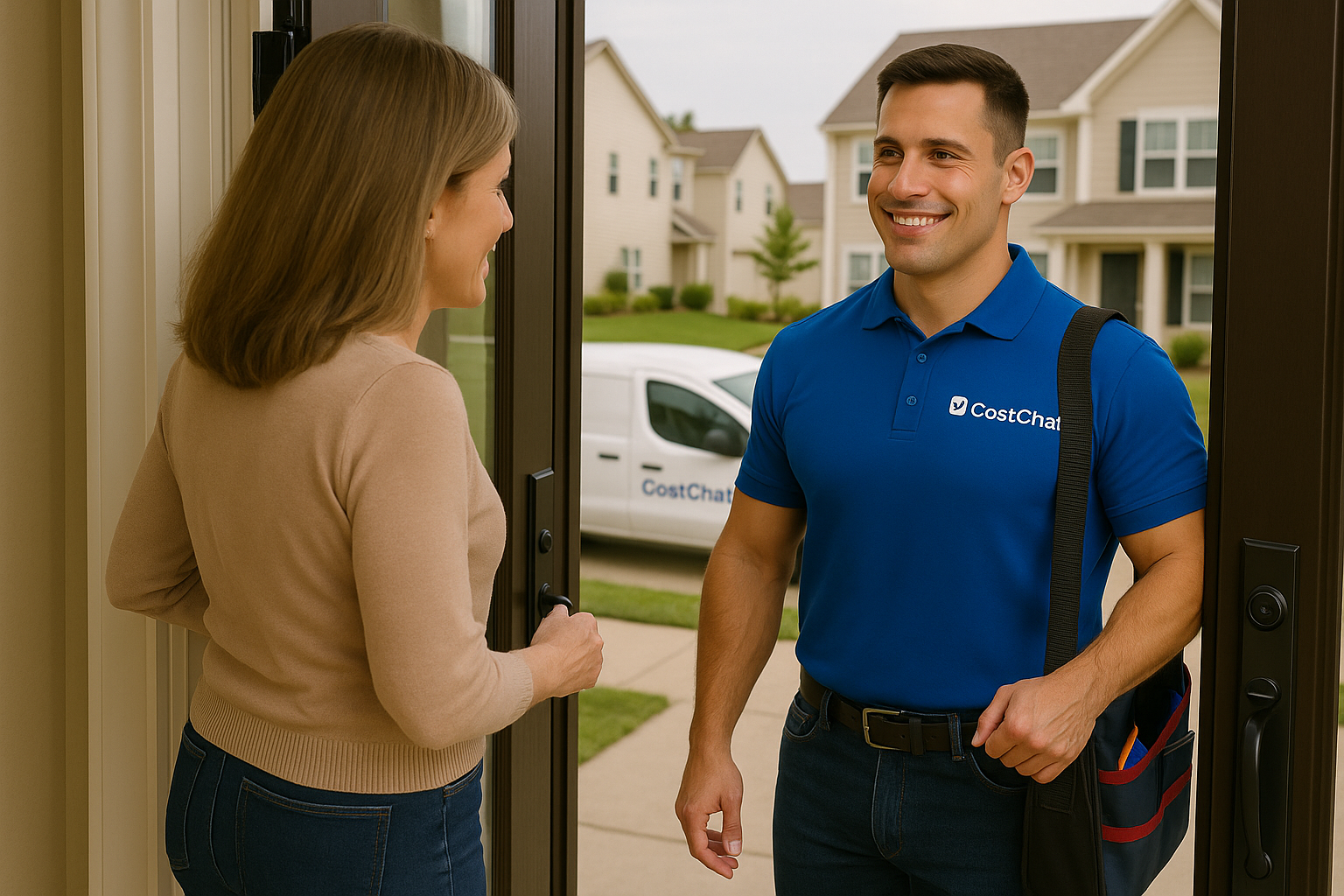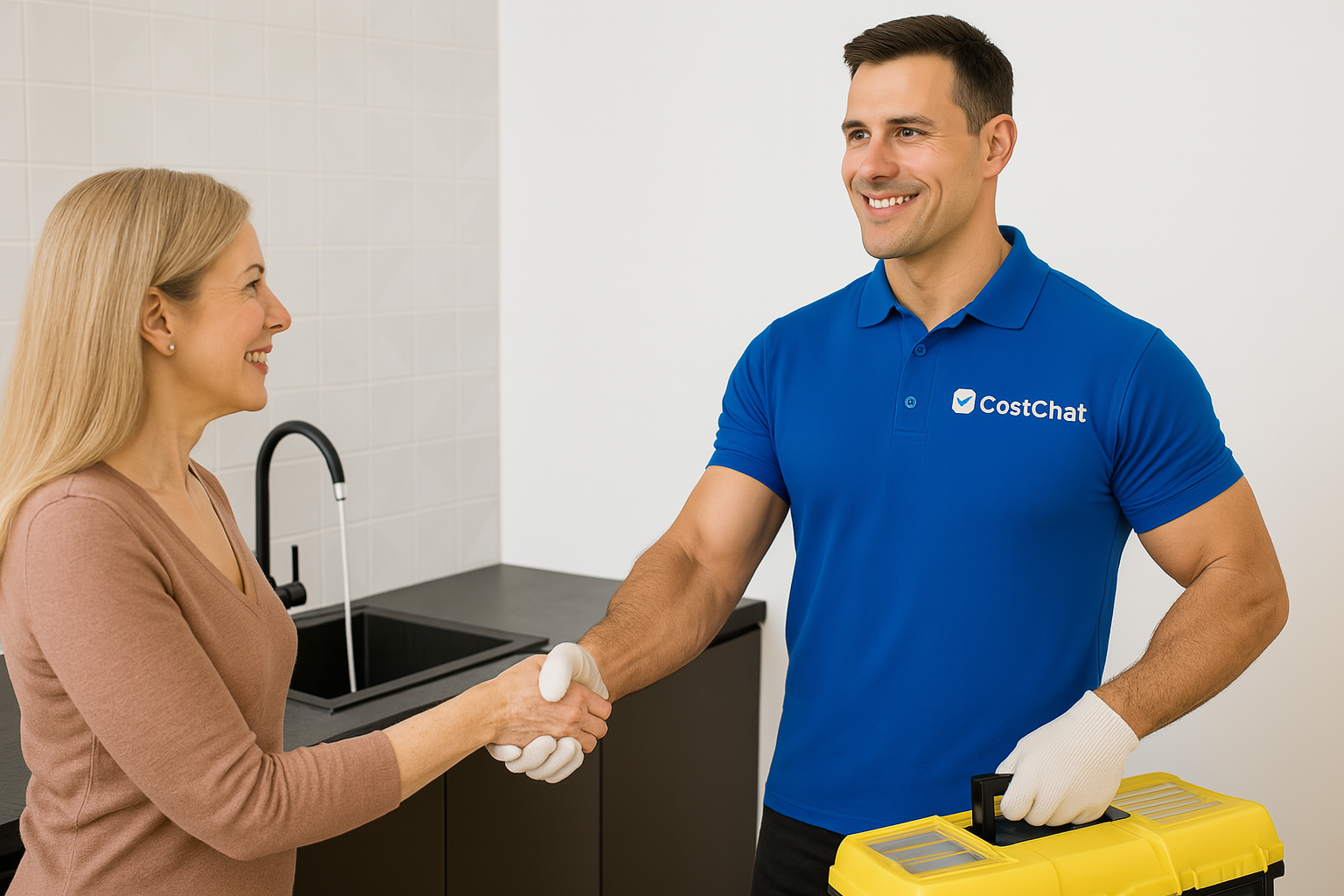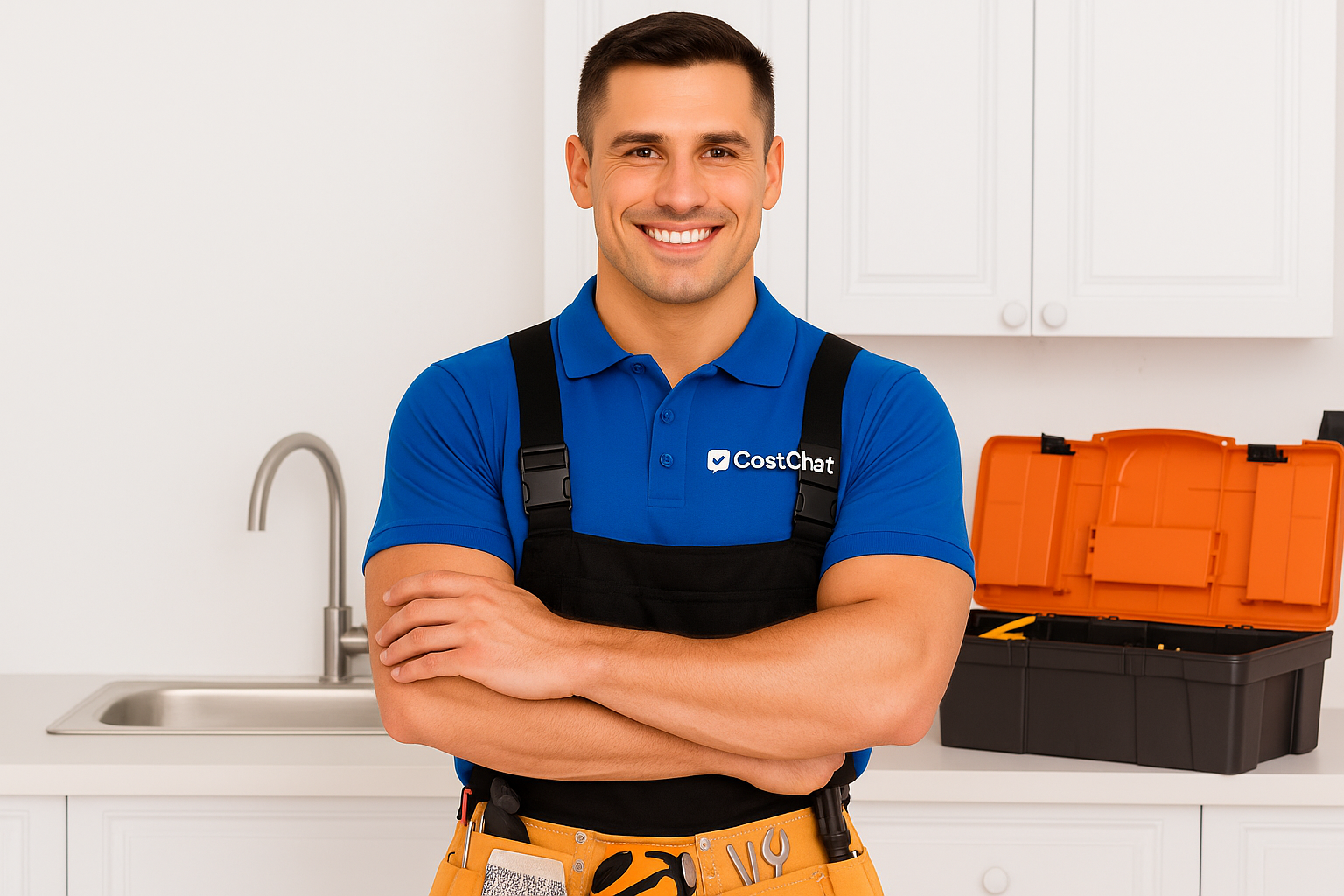
Your Go-To Commercial Plumbing Team in Cincinnati, OH
How to Hire Top Rated Commercial Plumbing Pros in Cincinnati, OH
Get a Free Online Estimate
Share your project details and receive a free online estimate from top-rated local pros. Not sure what it should cost? Check our Cost Guide.
Get EstimateCompare Local Quotes
View multiple free online quotes side by side. Use our Price Guide to understand labor rates, materials, and service fees before you hire.
Compare NowBook Best Top Rated Pros
Choose a licensed pro with confidence. Lock in your date after reviewing your free estimate and browsing our expert Cost Guide for peace of mind.
Book NowDid You Know?
74% ⚠️
of homeowners face surprise costs and delays — mostly from hiring unvetted pros. Don’t risk it. Hire trusted experts today.
Hire Top Rated & Verified ProsWork With Verified & Trusted Pros 🛡️
Save time, avoid costly mistakes, and experience reliable, top-quality service for every home project. Book now for priority scheduling and peace of mind.
Hire a Top Rated ProGet Instant Online Estimate of Commercial Plumbing in
🔎 CostChat Online Cost Estimator
Describe your project and location to get an instant estimate.
Your Ultimate Guide to Commercial Plumbing Services in Cincinnati, OH
Welcome, Cincinnati homeowners! We understand that maintaining a comfortable and functional home is a top priority. When it comes to the essential systems that keep your household running smoothly, reliable plumbing is paramount. Whether you're dealing with an aging system in a historic Hyde Park bungalow or planning an upgrade in a newer build, understanding the nuances of commercial plumbing services in Cincinnati, OH, is key. This comprehensive guide is designed to equip you with the local knowledge you need to make informed decisions about your home's plumbing, from understanding potential issues rooted in our city’s unique character to navigating regulations and finding trusted professionals.
Table of Contents
- Cincinnati, OH's Unique Commercial Plumbing Landscape: Why Local Expertise Matters
- Neighborhood Hotspots: Micro-Local Commercial Plumbing Risks & Solutions
- Common Problems & Triggers for a Professional Commercial Plumbing Call
- Navigating Cincinnati, OH's Regulations: Permits, Code & Professional Licensing
- Maximize Your Savings: Cincinnati, OH Commercial Plumbing Rebates & Incentives
- Choosing Your Cincinnati, OH Commercial Plumbing System: Models, Sizing & Smart Features
- Cost of Commercial Plumbing in Cincinnati, OH
- Hiring Cincinnati, OH's Top-Rated Commercial Plumbing Professional: Your Action Plan
- FAQs About Commercial Plumbing in Cincinnati, OH
Cincinnati, OH's Unique Commercial Plumbing Landscape: Why Local Expertise Matters
The Age & Character of Cincinnati, OH Homes: A Commercial Plumbing-Related Time Capsule
Cincinnati, OH, with an estimated 2025 population of around 312,000 residents within approximately 79 square miles, boasts a diverse housing stock reflecting its rich history. Many neighborhoods feature homes built from the early to mid-20th century, including charming Craftsman bungalows, elegant Colonial Revivals, and post-war suburban residences. Iconic areas like Hyde Park, Oakley, and Mount Adams showcase this blend, often with original plumbing systems that may require expert attention due to their age. Homes constructed before the 1950s frequently contain older materials such as galvanized steel pipes, which are susceptible to internal corrosion and mineral buildup, leading to reduced water pressure and leaks. Similarly, cast iron drains, common in older constructions, can deteriorate, causing blockages and potential leaks. For homes with concrete foundations, slab leaks can be a significant concern, exacerbated by soil conditions and ground movement inherent to our region.
Commercial Plumbing's Environmental & Utility Factors & Climate Impact on Your Plumbing System
Cincinnati's climate, characterized as humid continental, presents specific challenges for plumbing systems. We experience cold winters with freeze-thaw cycles that can cause pipes to freeze and crack if not properly insulated. The region's variable rainfall and clay-heavy soil can lead to ground expansion and contraction, stressing underground plumbing lines and contributing to issues like slab leaks. Proximity to the Ohio River also introduces flooding risks in some areas, necessitating protection measures like sump pumps and backflow preventers for basement plumbing. The Greater Cincinnati Water Works (GCWW) supplies our city's water, drawing from both the Ohio River and the Great Miami Buried Valley Aquifer. GCWW employs rigorous multi-stage filtration and treatment processes to ensure safe, regulated tap water. While the water is classified as moderately hard, which can contribute to mineral scale buildup in pipes and fixtures over time, GCWW's treatment and corrosion control measures help manage this. Regular plumbing inspections and considering water softening options can further mitigate scale deposits and prolong the life of your plumbing system.
 Get a Quote
Get a QuoteNeighborhood Hotspots: Micro-Local Commercial Plumbing Risks & Solutions
Cincinnati's diverse neighborhoods often present unique plumbing challenges due to their age, construction materials, and specific environmental factors. Understanding these micro-local risks can help you anticipate and address potential issues proactively.
Hyde Park & Oakley: Historic Charm, Aging Infrastructure
Homes in Hyde Park and Oakley, known for their mid-century architecture, often feature original plumbing systems. Common issues include corroded galvanized pipes and aging drain lines, leading to reduced water flow and leaks. For these areas, a comprehensive inspection and potential repiping with modern PEX or copper are often recommended to ensure long-term reliability.
Mount Adams: Steep Terrain & Foundation Concerns
The unique topography of Mount Adams can sometimes lead to increased stress on underground plumbing lines due to soil shifts and gravity. Homes here may experience issues related to underground leaks. Careful assessment of external plumbing lines and robust foundation considerations are crucial for Mount Adams residents.
Downtown Cincinnati & Over-the-Rhine: Older Buildings, Complex Systems
Many properties in the downtown core and Over-the-Rhine are historic buildings with complex, interconnected plumbing systems. These can be prone to blockages in older drain lines and require specialized knowledge for repairs and upgrades to maintain historical integrity while ensuring modern functionality.
Common Problems & Triggers for a Professional Commercial Plumbing Call
Recognizing the signs that your plumbing system needs professional attention is vital for preventing more severe and costly damage. Several common issues, often exacerbated by Cincinnati's specific conditions, warrant a call to a qualified commercial plumber.
Signs Your Cincinnati, OH Plumbing Needs Immediate Attention
- Reduced Water Pressure: Often caused by internal pipe corrosion, especially in older galvanized pipes common in many Cincinnati homes.
- Slow Drains or Clogs: Can indicate buildup in drain lines, potentially from decades of use or inadequate pitch in older installations.
- Foul Odors from Drains: May signal sewer line issues or failing traps, exacerbated by potential ground settling.
- Water Leaks: From dripping faucets to visible pipe leaks, these are immediate red flags. Consider checking our guide on Warning Signs Your Plumbing Needs Attention for more indicators.
- Gurgling Sounds: Often a sign of venting issues or significant blockages in the drainage system.
- High Water Bills: Unexplained increases can point to undetected leaks within your plumbing system.
Underlying Causes and Lifespan Considerations
Many of these problems stem from the natural aging of plumbing materials. Galvanized steel pipes typically have a lifespan of 40-60 years, cast iron drains can last 50-100 years, and copper pipes can endure 50-100+ years. However, the lifespan is heavily influenced by water quality and environmental factors. The moderately hard water in Cincinnati can lead to scale buildup, reducing the effective lifespan of pipes and fixtures if not managed. In older homes, remodeling can inadvertently disturb or exacerbate existing plumbing vulnerabilities, making professional assessment crucial during such projects. For any plumbing emergency, it's important to know how to react; consult What to Do in a Plumbing Emergency.
 Get a Quote
Get a QuoteNavigating Cincinnati, OH's Regulations: Permits, Code & Professional Licensing
Ensuring your plumbing work complies with local regulations is essential for safety, property value, and avoiding future complications. Cincinnati has specific requirements for plumbing projects.
Permitting and Inspections
Significant plumbing work in Cincinnati, such as repiping, installing new fixtures, or replacing water heaters, requires a permit from the Cincinnati Building and Inspections Department. You can find more information on their website: Cincinnati Building and Inspections Department. Permits ensure that the work meets safety standards and local codes. Typical inspections might include:
- Rough-in Inspection: Performed after pipes are installed but before walls are closed up, ensuring proper material, layout, and connections.
- Final Inspection: Conducted after all work is completed to verify that the system is installed according to code and functioning correctly.
Governing Code and DIY Considerations
Cincinnati adheres to the Ohio Plumbing Code, which is largely based on the International Plumbing Code but includes local amendments designed for regional conditions, such as frost protection and water conservation needs. While some minor plumbing tasks might be suitable for DIY enthusiasts, complex or critical installations are strongly recommended to be handled by licensed professionals. Incorrect installations can lead to leaks, water damage, code violations, and safety hazards. For guidance on what you can safely tackle yourself, explore our resource on When to Consider DIY.
Professional Licensing and Verification
All plumbers performing work in Ohio must be licensed by the Ohio Construction Industry Licensing Board (OCILB). Homeowners can verify a plumber's license and contractor registration by visiting the Ohio Department of Commerce website or using their online license lookup portal: Ohio Department of Commerce. Always ask for proof of license and insurance before hiring any professional.
Maximize Your Savings: Cincinnati, OH Commercial Plumbing Rebates & Incentives
Investing in water-efficient or energy-saving plumbing upgrades can pay off through various rebate and incentive programs available to Cincinnati residents. Taking advantage of these can significantly reduce the upfront cost of new installations or replacements.
Local and State Incentives for Water and Energy Efficiency
Greater Cincinnati Water Works (GCWW) and potentially state initiatives through the Ohio EPA often offer rebates for high-efficiency plumbing fixtures and appliances. These can include:
- High-Efficiency Toilets: Rebates are often available for toilets that meet specific water-saving standards.
- Water-Efficient Fixtures: Look for incentives on low-flow showerheads and faucets.
- Water Heater Rebates: Some programs may offer incentives for installing ENERGY STAR certified or high-efficiency water heaters.
It’s advisable to check the GCWW website and the Ohio EPA’s water conservation pages for the most current information on available programs, qualifying models, and application processes. For smart ways to save money on home services, see our Saving Tips guide.
Bonus Tip: Timing your upgrades strategically, perhaps when a major rebate program is active or in conjunction with other home improvement projects, can lead to even greater savings.
 Get a Quote
Get a QuoteChoosing Your Cincinnati, OH Commercial Plumbing System: Models, Sizing & Smart Features
Selecting the right plumbing components for your Cincinnati home involves considering various factors, from the type of system to specific features that best suit your household's needs and our local climate.
Commercial Plumbing System Options: Pros and Cons for Cincinnati Homes
When considering new plumbing installations or significant upgrades, common materials include:
- PEX (Cross-linked Polyethylene):
- Pros: Flexible, resistant to freezing, corrosion-resistant, easier and faster to install than copper, often more cost-effective.
- Cons: Susceptible to UV damage if exposed, may require specific fittings.
- Copper:
- Pros: Durable, long-lasting, corrosion-resistant, excellent for hot and cold water, fire-resistant.
- Cons: More expensive than PEX, can be susceptible to freezing and bursting if not insulated in cold climates, can corrode with highly acidic water.
Sizing and Application Guidance for Cincinnati, OH
Proper sizing of pipes and fixtures is crucial for optimal water flow and pressure. A professional plumber will assess your home's water demand based on the number of bathrooms, fixtures, and occupants. For Cincinnati homes, especially older ones with potentially undersized original pipes, upgrading to appropriately sized modern piping can significantly improve performance.
Key Commercial Plumbing Considerations for Cincinnati, OH Homes
- Freeze Protection: Ensuring pipes in unheated areas (like basements or crawl spaces) are properly insulated is vital due to our winter freeze-thaw cycles.
- Water Quality: While GCWW provides treated water, understanding its hardness can help in deciding on water softening solutions to protect fixtures and appliances.
- Drainage Systems: Older homes may have clay or cast iron drain lines that are prone to collapse or blockage. Assessing these lines for potential replacement is important.
- Backflow Prevention: Especially important for homes in flood-prone areas or those with sump pumps, to prevent sewer water from entering the home.
Cost of Commercial Plumbing in Cincinnati, OH
Understanding the potential costs associated with commercial plumbing services in Cincinnati, OH, is crucial for budgeting your home improvement projects. Costs can vary significantly based on the scope of work, materials used, and the complexity of the job.
- Hourly Rates: For general service calls or minor repairs, plumbers in Cincinnati typically charge between $75 to $150 per hour.
- Drain Cleaning: Expect costs ranging from $150 to $350 for basic drain clearing. More complex clogs requiring specialized equipment can increase this.
- Water Heater Replacement: A standard tank water heater replacement might cost between $800 to $1,500, while tankless units can range from $2,000 to $4,000 or more.
- Pipe Repair/Replacement (Repiping): This is a significant investment. A full repipe of a home using PEX might range from $4,000 to $8,000+, and copper could be higher. Costs are influenced by the size of the home and the accessibility of the existing plumbing.
- Slab Leak Detection and Repair: Due to the specialized equipment and labor involved, slab leak services can range from $1,000 to $3,000 or more.
Factors influencing these costs include the age of your home's existing plumbing (older materials like galvanized pipes may require more labor or specialized handling), the specific neighborhood (access and parking can sometimes play a minor role), and the brand and quality of materials chosen. It is always recommended to obtain multiple detailed quotes from licensed and insured Cincinnati plumbers to compare services and pricing.
 Get a Quote
Get a QuoteHiring Cincinnati, OH's Top-Rated Commercial Plumbing Professional: Your Action Plan
Choosing the right professional for your commercial plumbing needs in Cincinnati is as important as the service itself. A skilled and trustworthy plumber ensures quality work and peace of mind.
Actionable Tips for Homeowners
- Verify Licensing and Insurance: Always confirm that your chosen plumber is licensed by the OCILB and carries adequate liability insurance and worker's compensation. This protects you from potential damages or injuries.
- Ask Hyper-Local Questions: Engage potential plumbers with questions specific to Cincinnati, such as:
- "What are the common plumbing issues you see in homes built before 1960 in the Hyde Park area?"
- "How do you handle potential pipe freezing during Cincinnati winters?"
- "What are your recommendations for managing the moderately hard water common in our city?"
- Check Local Reviews and Testimonials: Look for reviews on local platforms and ask for references from neighbors or friends who have used their services.
- Obtain Multiple Detailed Quotes: Request itemized quotes from at least three different professionals. Ensure they clearly outline the scope of work, materials, labor costs, and any potential additional charges.
- Demand a Written Contract: A comprehensive contract should detail all aspects of the job, including timelines, payment schedules, warranties, and the exact services to be performed.
Avoiding common pitfalls is crucial. For further guidance on what to avoid, consult our Mistakes to Avoid guide.
Neighborhoods We Serve in Cincinnati, OH
️ Top Neighborhoods:
- Downtown
- Over-the-Rhine
- Mount Adams
- Clifton
- Corryville
- Hyde Park
- Walnut Hills
- East Walnut Hills
- Mount Lookout
- Mount Washington
- Avondale
- Northside
- College Hill
- Pendleton
- West End
Top ZIP Codes Covered:
- 45202
- 45203
- 45204
- 45205
- 45206
- 45207
- 45208
- 45209
- 45211
- 45212
- 45213
- 45214
- 45216
- 45219
- 45220
Wherever you’re located in Cincinnati, OH, our team of trusted local pros is nearby—ready to deliver fast, reliable, and top-rated service. Whether you’re in the heart of downtown or a quiet suburb, we’ve got you covered.
FAQs About Commercial Plumbing in Cincinnati, OH
Older Cincinnati homes, particularly those built before the 1950s, commonly experience issues with galvanized steel pipes that corrode internally, leading to reduced water pressure and leaks. Cast iron drain lines are also prone to deterioration and blockages. Our team often sees these problems in neighborhoods like Hyde Park and Mount Adams.
Cincinnati's humid continental climate brings cold winters with freeze-thaw cycles that can cause pipes to freeze or burst if not properly insulated. Additionally, clay-heavy soils prevalent in the region can expand and contract with seasonal moisture changes, stressing underground plumbing and potentially causing slab leaks.
Greater Cincinnati Water Works (GCWW) supplies water, sourcing primarily from the Ohio River and the Great Miami Buried Valley Aquifer. GCWW uses rigorous multi-stage filtration and treatment processes, including UV light and corrosion control, to ensure the water is safe and meets all regulatory standards. The water is considered moderately hard, which may contribute to mineral buildup over time.
Yes, permits are generally required for significant plumbing work such as repiping, installing new fixtures, or replacing water heaters. The Cincinnati Building and Inspections Department manages permits to ensure compliance with the Ohio Plumbing Code and safety standards. Always check with the department before starting major projects.
Costs can vary based on the complexity of the job, the materials used (e.g., PEX vs. copper), the age and condition of your existing plumbing system, and the specific neighborhood. Emergency services or work requiring specialized equipment like slab leak detection will also impact the overall price. Obtaining detailed quotes from multiple licensed plumbers is recommended.
